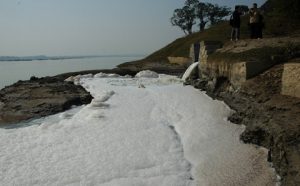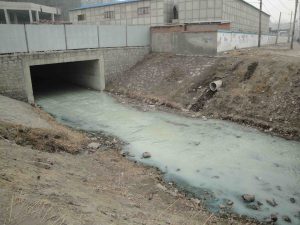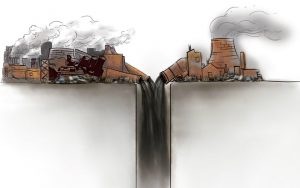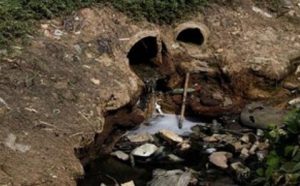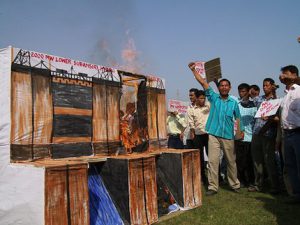Wu Zhiqiang lives in a village in Inner Mongolia and has visited over a dozen hospitals locally and in Beijing over the last twenty years, looking for help with arsenic poisoning. His palms are covered with thick calluses: “They’re hard and grasping any object is agonising,” he told the China Youth Daily. There are more on his body – black, white, green, “like a carpet.”
One tenth of the 229 people in his village show symptoms of arsenic poisoning. According to the village Party secretary, Wu is one of the three or four most severe cases who are no longer able to work.
A survey conducted by the Chinese National Survey Program between 2001-5 found 10,000 patients in China had symptoms of arsenic poisoning in known and suspected endemic areas, including Xinjiang, Inner Mongolia, Henan, Shandong and Jiangsu. However, a study published in September this year estimated that as many as 19.6 million people are likely to be at risk.
In the 1960s the use of drilled wells to extract groundwater for drinking became common. “But that water,” said Sun Guifan, a professor at China Medical University’s School of Public Health, “was very likely contaminated with arsenic.” The World Health Organisation’s safe limit for arsenic in groundwater is 10 micrograms per litre – drinking water that breaches that limit in the long term is dangerous.
China’s first reported case of arsenic poisoning from water was found in Xinjiang in 1980, with others later found in Inner Mongolia, Shanxi, and elsewhere. In the early 1990s arsenic poisoning was identified as one of China’s five major regional afflictions by the Ministry of Health.
Arsenic poisoning is a chronic disease and it can take decades for symptoms to appear. In 1993, when Sun returned from studying in Japan, the Ministry of Health had just identified arsenic poisoning as a regional disease: “The public got scared, and that was reported all the way up to the State Council. So we knew it was important to study the disease.”
In mid-August Sun travelled to Switzerland, where the American Institute for the Advancement of Science was holding a press conference to announce the findings of groundwater arsenic contamination throughout China, a report compiled over four years by Chinese, Swiss and Spanish researchers, at the Swiss Federal Institute of Aquatic Science and Technology. The report’s map of arsenic contamination in China featured on the cover of Science magazine.
On that map places such as Xinjiang, Inner Mongolia and Shanxi are coloured red and yellow, indicating heavier contamination.
Other previously unknown or ignored danger areas were also highlighted, including the west of Liaoning, Shandong, Jiangsu, Anhui, Henan, central Sichuan and the Hei River watershed in Gansu. Certain parts of Beijing are also at risk.
Sun, one of the report’s authors, said that this model is crucial. For years the authorities were only aware of arsenic contamination once it had become a problem. “It’s easy to use alternative water supplies, but first you’ve got to know where they are needed.” Wu Zhiqiang’s village, and almost all of the nearby Great Bend plain, is coloured red or yellow on the map – Wu is living in an area where groundwater is likely to be contaminated with arsenic.
According to the model for predicting arsenic contamination, 19 million live in regions where groundwater arsenic exceeds safe levels.
Between 2001 and 2005 the Ministry of Health had research institutes test arsenic levels at 445,000 wells around the country – but that is less than one eighth of China’s wells and it might take another 20 years to cover them all.
In 2009 scientists from China, Switzerland and Spain got to work on a method for predicting arsenic levels in China’s groundwater without that testing. Sun stressed that this was an unusual project – the team was cross-disciplinary and international. “We had geologists, geochemists, hydrologists, remote sensing experts, with Chinese researchers specialising in human health and the actual collection of samples.”
The researchers gathered eight different types of data, including geological parameters, chemical indices, physical data and information on soil types, with the aim of mapping the risk of arsenic contamination. That data and samples taken from 2,600 villages were used to estimate the risk of groundwater arsenic contamination across an area of 580,000 square kilometres. Areas with the highest risk were coloured red. The model is accurate to within one kilometre.
Testing of the model found it was accurate to 77% in predicting which areas would be contaminated, and 85% in predicting which areas would be safe.
Although 19.58 million people live in areas at high risk, “that doesn’t mean 19.58 million people have arsenic poisoning,” explained Sun. “That figure includes urban populations, which drink from piped water,” which “has been treated and meets the standard.”
Chen Tongbin, director of the Environmental Restoration Centre at the Institute of Geographic Sciences and Natural Resources Research, pointed out that in 2005 the China Centre for Disease Control and Prevention had used Ministry of Health data on arsenic contamination to estimate that 14.7 million people were living in areas with excessive levels of arsenic, and 5.6 million of them in high risk areas.
Lives ruined by arsenic
When Wu Zhiqiang first noticed something wrong with his skin in 1987, the local doctor diagnosed ordinary skin problems such as corns. Over the years he tried to tell doctors he had arsenic poisoning – only to be asked what arsenic was.
Sun has met patients like Wu who don’t know what disease they have. Some think their headaches are due to overwork, and some go to dermatologists with their skin problems. “Who would have thought they might be drinking arsenic?”
Sun has a very simple solution to the problem: “there’s just one option, changing the water.”
During the 11th Five Year Plan the government invested billions of yuan in new water supplies. Work in the worst affected areas has already been completed – Wu’s village now drinks clean mineral water, and the disease is under control.
But that just deals with groundwater contamination, and as Chen points out, the soil is also a problem. “It’s much harder to clean up arsenic in the soil.” In his office he has pots of a type of grass which absorbs arsenic from the soil, which he describes as “the most effective method of removing arsenic to be found so far.”Arsenic has already wrecked Wu Zhiqiang’s life – his marriage has ended and he lives with his mother and son in a 20 square meter room, relying on welfare payments. In July the hospital told him his disease wasn’t getting worse, but that “you might not recover even after ten years.”
A version of this article was originally published in the China Youth Daily
